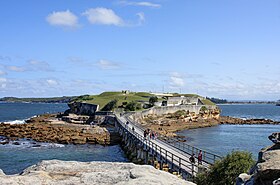 Footbridge from La Perouse leading to Bare Island | |
Location in Sydney | |
| Geography | |
|---|---|
| Location | La Perouse, Sydney, New South Wales, Australia |
| Coordinates | 33°59′32″S 151°13′52″E / 33.99222°S 151.23111°E |
| Adjacent to | Botany Bay |
| Demographics | |
| Population | unpopulated |
| Additional information | |
Building details | |
 | |
| Former names | Bare Island Fort |
| General information | |
| Status | Historic site |
| Type |
|
| Construction started | 1881 |
| Completed | 1889 |
| Owner | Office of Environment and Heritage |
| Design and construction | |
| Architect(s) |
|
| Main contractor | John McLeod, NSW Public Works |
| Official name | Bare Island Fort |
| Type | State heritage (complex / group) |
| Criteria | a., c., d., e., f., g. |
| Designated | 2 April 1999 |
| Reference no. | 978 |
| Type | Fortification |
| Category | Defence |
| Builders | John McLeod NSW Department of Public Works |
Bare Island is a heritage-listed islet[1] located at La Perouse, New South Wales in the Eastern Suburbs of Sydney in eastern Australia. The islet is located about 16 kilometres (9.9 mi) south east of the Sydney central business district, within Botany Bay, close to the bay's northern headland. Containing former fortification facilities, Bare Island was a former war veterans' home and museum and is now a historic site that was added to the New South Wales State Heritage Register on 2 April 1999 and is significant as an almost completely intact example of late nineteenth century coastal defence technology.[2] It was designed by Sir Peter Scratchley, Gustave Morell and James Barnet and built from 1881 to 1889 by John McLeod on behalf of the NSW Department of Public Works.

Bare Island is connected by a footbridge to the mainland of La Perouse. The heritage-listed military fort and tunnels can only be visited by guided tour. The waters around the island are popular with scuba divers.[3][4] The Bare Island anglerfish is named after this island.
- ^ "Bare Island". Geographical Names Register (GNR) of NSW. Geographical Names Board of New South Wales. Retrieved 8 October 2014.
- ^ "Bare Island Fort". New South Wales State Heritage Register. Department of Planning & Environment. H00978. Retrieved 2 June 2018.
 Text is licensed by State of New South Wales (Department of Planning and Environment) under CC-BY 4.0 licence.
Text is licensed by State of New South Wales (Department of Planning and Environment) under CC-BY 4.0 licence.
- ^ Pollen, Frances (1990). The Book of Sydney Suburbs. Australia: Angus & Robertson Publishers. ISBN 0-207-14495-8.
- ^ "Bare Island - Dive Summary". Michael McFadyen's Scuba Diving Web. Archived from the original on 14 October 2014.
